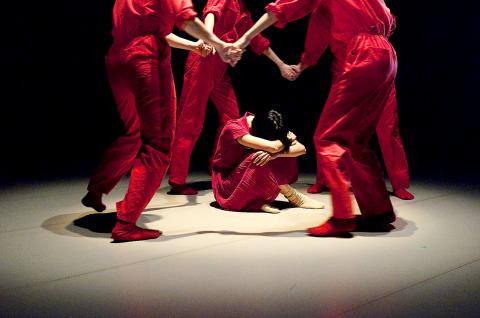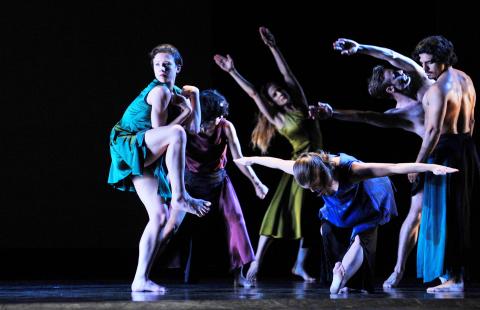Buoyancy and light were the order of the day at the National Theater in Taipei last weekend, while the Experimental Theater was filled with loneliness and despair — and cherry red jumpsuits.
The Mark Morris Dance Group on Saturday night exceeded the high expectations that had heralded its arrival, while Scarecrow Contemporary Dance Company’s (稻草人現代舞蹈團) latest production, Singular (單‧身), upstairs in the Experimental Theater earlier in the day, gave a rather depressing outlook on life.
Morris’ mixed program opened with a recent work, last year’s Crosswalk, set to Carl Maria von Weber’s Grand Duo Concertant, for Clarinet and Piano, which was light and lyrical, though with a hint of underlying darkness. The work exemplifies his musicality and imagination. The dancers — women dressed in tangerine and orange tops and skirts, the men in white T-shirts and dark pants — run, skip and tumble across the stage in bursts of energy. However, in the midst of all this fun, pushing and shoving between two women and one man belie the lightness that surround them.

Credit: Courtesy of Liu Ren-haur / Scarecrow Contemporary Dance Company
All Fours, from 2003, is set to Bela Bartok’s String Quartet No. 4, emitted a much darker mood. The demanding music evokes feelings of uncertainty, which are reflected in the stark, harsh movements of the dancers, who frequently clasp their hands above their heads as if in desperate prayer.
Symmetry is key to Festival Dance which premiered in 2011 and is set to Johann Nepomuk Hummel’s Piano Trio No. 5 in E Major. The piece begins and ends with a couple embracing to the right of the stage. The 12 dancers twirl in pairs or divide in half, joining hands for geometric line dancing. The movements are reminiscent of simpler times, of village fetes and harvest celebrations, and brought to mind Jerome Robbins’ Dances at a Gathering. The piece represents what so many love about Morris’ work — the lush romantic lyricism and grace of classical ballet, but without the tutus, tights and toe shoes.
A key element to all three works on the program was that the dancers were accompanied by the troupe’s seven-man music ensemble, in various formations. The rippling notes of the piano appeared to give added lift to the dancers in Crosswalk and Festival Dance. Dance just seems to breathe to live music and music has always been the key to Morris’ works.

Photo: Mandy Cheng, AFP
The Mark Morris Dance Group will perform at the Tainan Municipal Cultural Center in Greater Tainan tomorrow and Friday. Friday night will be the same program I saw; tomorrow night is Program A, which is composed of two pieces set to Mozart — Eleven, set to Piano Concerto No. 11 in F major, K. 413, and Double, set to Sonata for Two Pianos in D major, K. 448 and Grand Duo, which is set to Lou Harrison’s Grand Duo for Violin and Piano.
Scarecrow artistic director and choreographer Luo Wen-jinn (羅文瑾) cited US author Paul Auster’s The Invention of Solitude as inspiration for Singular, which follows a “Time Wanderer” — whose image was derived from Luo’s father — through different eras and a multitude of meetings, partings, separations and rejections.
A quick look at the names of some of the other characters in the program and it is easy to see there will be no happy endings: Kid Without Love, Lonely Woman, Mother With Hollow Soul and Rejected Girl.
Luo shows that isolation is not just a human concept, with her fighting fish scenes and a flock of panicked birds. The pain comes from the repeated attempts by the rejected to insert themselves into pairings and group activities despite continual rebuffs.
The vast white tiled wall that formed the backdrop to Singular conveyed both an image of modern urban in Taiwan, with its omnipresent tiled apartment buildings, and formed a barrier that kept the characters trapped within their stories.
Despite the painful subject, the choreography and the eight dancers, including Luo herself, were always interesting to watch. Most of the dancers portrayed multiple roles that required repeated quick costume changes, so kudos to their off-stage helpers who made that happen.
With Singular, Scarecrow Contemporary Dance Company continues to demonstrate that a troupe does not have to be based in Taipei to remain topical, edgy or adventurous.
This story has been amended since first published to correct the photo captions.

Following the rollercoaster ride of 2025, next year is already shaping up to be dramatic. The ongoing constitutional crises and the nine-in-one local elections are already dominating the landscape. The constitutional crises are the ones to lose sleep over. Though much business is still being conducted, crucial items such as next year’s budget, civil servant pensions and the proposed eight-year NT$1.25 trillion (approx US$40 billion) special defense budget are still being contested. There are, however, two glimmers of hope. One is that the legally contested move by five of the eight grand justices on the Constitutional Court’s ad hoc move

Stepping off the busy through-road at Yongan Market Station, lights flashing, horns honking, I turn down a small side street and into the warm embrace of my favorite hole-in-the-wall gem, the Hoi An Banh Mi shop (越南會安麵包), red flags and yellow lanterns waving outside. “Little sister, we were wondering where you’ve been, we haven’t seen you in ages!” the owners call out with a smile. It’s been seven days. The restaurant is run by Huang Jin-chuan (黃錦泉), who is married to a local, and her little sister Eva, who helps out on weekends, having also moved to New Taipei

The Directorate-General of Budget, Accounting and Statistics (DGBAS) told legislators last week that because the Chinese Nationalist Party (KMT) and Taiwan People’s Party (TPP) are continuing to block next year’s budget from passing, the nation could lose 1.5 percent of its GDP growth next year. According to the DGBAS report, officials presented to the legislature, the 2026 budget proposal includes NT$299.2 billion in funding for new projects and funding increases for various government functions. This funding only becomes available when the legislature approves it. The DGBAS estimates that every NT$10 billion in government money not spent shaves 0.05 percent off

Dec. 29 to Jan. 4 Like the Taoist Baode Temple (保德宮) featured in last week’s column, there’s little at first glance to suggest that Taipei’s Independence Presbyterian Church in Xinbeitou (自立長老會新北投教會) has Indigenous roots. One hint is a small sign on the facade reading “Ketagalan Presbyterian Mission Association” — Ketagalan being an collective term for the Pingpu (plains Indigenous) groups who once inhabited much of northern Taiwan. Inside, a display on the back wall introduces the congregation’s founder Pan Shui-tu (潘水土), a member of the Pingpu settlement of Kipatauw, and provides information about the Ketagalan and their early involvement with Christianity. Most